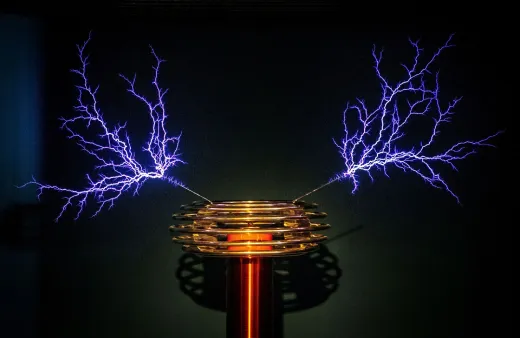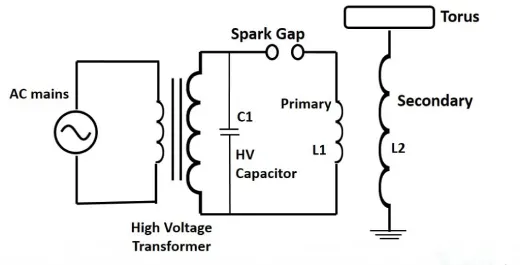Tesla Coil : Overview, Principle & Applications
Welcome to the realm of coil technology! Countless coil applications, such as coil-powered lighting, smart homes, and chargers, have emerged thanks to advancements in coil technology. One of the most iconic breakthroughs in this domain occurred in 1891 with Nikola Tesla's invention of the Tesla coil. Tesla's relentless pursuit of coil energy culminated in the creation of this coil, which, owing to its simplicity, has seamlessly integrated into our daily lives. From remote controls to smartphones, computers, X-rays, neon and fluorescent lights, and beyond, the Tesla coil plays a pivotal role in powering various modern conveniences.

What is a Tesla Coil?
A Tesla coil is essentially a radio frequency oscillator designed to energize an air-core double-tuned resonant transformer, generating high voltages while maintaining low currents.
For a clearer understanding, let's delve into the definition of a radio frequency oscillator. Broadly speaking, an electronic oscillator is a device that generates electrical signals, typically in the form of sine waves or square waves. Specifically, a radio frequency oscillator produces signals within the radio frequency range, spanning from 20 kHz to 100 GHz, hence earning its designation as a radio frequency oscillator.
Principle of Operation of the Tesla Coil
The Tesla coil possesses the capability to generate output voltages reaching several million volts, the magnitude of which is contingent upon the coil's dimensions. Its operation hinges on the principle of resonance. In this context, the primary coil dispatches substantial currents into the secondary coil, saturating the secondary circuit with maximal energy. A precisely tuned circuit facilitates the transmission of current from the primary to the secondary circuit at a resonant frequency.
Circuit Arrangement of the Tesla Coil
Comprising two fundamental components—a primary coil and a secondary coil—each equipped with its own capacitor, the Tesla coil circuit is structured for optimal performance. Bridging the coils and capacitors is a spark gap, integral to the system's operation as it facilitates the generation of sparks to energize the setup.

Principle of the Tesla Coil
This apparatus harnesses a specialized transformer known as a resonant transformer, a radio-frequency transformer, or an oscillation transformer.
The primary coil, connected to a power source, interfaces with the secondary coil of the transformer, designed for loose coupling to facilitate resonance. A capacitor, integrated in parallel with the transformer circuit, functions as a tuning circuit or an LC circuit, generating signals at a designated frequency.
The primary of the transformer, also known as a resonant transformer, elevates the voltage to exceedingly high levels, typically ranging from 2kV to 30kV, subsequently charging the capacitor. As the capacitor accumulates substantial charge, it ultimately breaches the air gap of the spark gap. This discharge results in the release of a substantial current through the Tesla Coil (L1, L2), consequently producing high voltage at the output.
Frequency of Oscillation
The integration of a capacitor and the primary winding 'L1' constitutes a tuned circuit, ensuring precise resonance alignment between both the primary and secondary circuits. The resonant frequencies of the primary 'f1' and secondary 'f2' circuits are determined by the formulas:
f1 = 1/2π√L1C1 and f2 = 1/2π√L2C2
Given that the secondary circuit cannot be adjusted, the adjustable tap on 'L1' is utilized to fine-tune the primary circuit until both circuits resonate harmoniously at the same frequency. Consequently, the frequency of the primary coincides with that of the secondary:
f = 1/2π√L1C1 = 1/2π√L2C2
The condition for achieving resonance between the primary and secondary circuits is expressed as:
L1C1 = L2C2
Unlike conventional transformers, the output voltage in a resonant transformer is independent of the number of turns ratio. At the onset of each cycle, energy accumulates within the primary capacitor 'C1', culminating in a breakdown voltage denoted as 'V1':
W1 = 1/2C1V12
Similarly, the energy within the secondary coil is represented as:
W2 = 1/2C2V22
Assuming no energy losses occur, W2 equals W1. Simplifying this relationship yields:
V2 = V1√C1/C2 = V1√L2/L1
In this equation, peak voltage can be achieved provided air breakdowns do not transpire. The peak voltage marks the threshold at which air breakdown initiates conductivity.
Pros and Cons of Tesla Coil
Pros:
Facilitates uniform voltage distribution across winding coils.
Gradually ramps up voltage, mitigating the risk of damage.
Boasts exceptional performance metrics.
Utilization of 3-phase rectifiers for higher power applications enables substantial load sharing.
Cons:
Tesla coil presents numerous health risks attributed to high-voltage radio frequency emissions, potentially causing skin burns, nerve damage, and cardiac issues.
Procuring large DC smoothing capacitors entails significant costs.
Constructing the circuit demands meticulous attention to detail and time investment to achieve resonance perfection.
Applications of Tesla Coil
Currently, these coils don't necessitate elaborate circuits to yield high voltage. However, compact Tesla coils are employed across various domains.
Aluminum welding
Automobiles utilize these coils for spark plug ignition
Tesla coil enthusiasts have crafted devices like Tesla coil fans, leveraging them for generating artificial lighting and sound, akin to musical tones
In the Entertainment and Education sectors, Tesla coils serve as captivating attractions at electronics exhibitions and science museums
Deployed in high vacuum systems and arc lighters
Utilized in vacuum system leak detectors
Frequently Asked Questions (FAQs)
1). What is the function of Tesla coils?
These coils serve as radio frequency oscillators, propelling resonant transformers to generate high voltages at low currents.
2). Can Tesla coils charge smartphones?
Modern smartphones often incorporate built-in coil charging, which operates on the principles underlying Tesla coils.
3). Are Tesla coils hazardous?
Yes, Tesla coils and their associated equipment pose significant risks due to the production of exceptionally high voltages and currents that can be lethal to humans.
4). Why do Tesla coils produce music?
Tesla coils typically induce the conversion of surrounding air into plasma, resulting in fluctuations in volume that propagate in all directions, culminating in the production of sound or music. This occurs at frequencies ranging from 20 to 100 kHz.
5). How did Tesla transmit electricity coilly?
Utilizing a spark gap to connect capacitors and two coils, Tesla transmitted electricity coilly by channeling power through a transformer, thereby generating the requisite current to power the entire circuit.
In summary
The Tesla coil offers a comprehensive overview, demonstrating its capacity to produce high-voltage, low-current, and high-frequency electricity. Remarkably, the Tesla Coil can transmit electricity coilly over considerable distances, spanning several kilometers. Through this article, we aim to provide readers with a deep understanding of the Tesla coil's operation, its merits and demerits, and its diverse applications. Undoubtedly, Tesla's groundbreaking invention of coil electric energy transmission has revolutionized global communication paradigms.
Choose a Low Voltage Transformer: Comprehensive Guide
Inductor vs Resistor: What’s the Differences?
What is an Air Core Inductor? [Everything Explained]
Understanding Coupled Inductors: Operations and Practical Applications
CBC3225T102KR Inductors: Features, Specifications, and Datasheet
Inductor Fundamentals: Definitions, Functions, Features, Types, and Parameters
Do ECM Motors Have Capacitors?
Why Do Capacitors Explode?
What do Microminiature and Ultraminiature RF connectors entail?
Difference Between Serial and Parallel Communication










